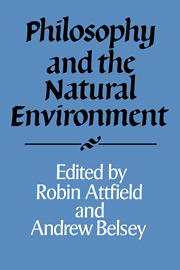Book contents
- Frontmatter
- Contents
- Preface
- Notes on Contributors
- Introduction
- Value in Nature and the Nature of Value
- Ecology and the Ethics of Environmental Restoration
- Rehabilitating Nature and Making Nature Habitable
- Personalistic Organicism: Paradox or Paradigm?
- Values, Reasons and the Environment
- Awe and Humility: Intrinsic Value in Nature. Beyond an Earthbound Environmental Ethics
- The End of Anthropocentrism?
- Global Religion
- Kant and the Moral Considerability of Non-Rational Beings
- The Idea of the Environment
- Chaos and Order, Environment and Anarchy
- Natural Capital
- Some Philosophical Assessments of Environmental Disobedience
- Global Environmental Justice
- Environmental and Medical Bioethics in Late Modernity: Anthony Giddens, Genetic Engineering and the Post-Modern State
- Highlights and Connections
- Bibliography
- Index
Rehabilitating Nature and Making Nature Habitable
Published online by Cambridge University Press: 19 October 2009
- Frontmatter
- Contents
- Preface
- Notes on Contributors
- Introduction
- Value in Nature and the Nature of Value
- Ecology and the Ethics of Environmental Restoration
- Rehabilitating Nature and Making Nature Habitable
- Personalistic Organicism: Paradox or Paradigm?
- Values, Reasons and the Environment
- Awe and Humility: Intrinsic Value in Nature. Beyond an Earthbound Environmental Ethics
- The End of Anthropocentrism?
- Global Religion
- Kant and the Moral Considerability of Non-Rational Beings
- The Idea of the Environment
- Chaos and Order, Environment and Anarchy
- Natural Capital
- Some Philosophical Assessments of Environmental Disobedience
- Global Environmental Justice
- Environmental and Medical Bioethics in Late Modernity: Anthony Giddens, Genetic Engineering and the Post-Modern State
- Highlights and Connections
- Bibliography
- Index
Summary
Can nature be reconstituted, recreated or rehabilitated? And would the goal of doing so be a desirable one? There again, is wild nature intrinsically valuable, or are parks, gardens and farms sometimes preferable or of greater value? This cluster of questions arises from recent debates about preservation, restoration, wilderness and sustainable development. In discussing them I hope to throw some light on both the concept and the value of nature, and in due course on the attitudes which people should have towards it, the policies which should guide their practice, and thus on the proper role of humanity with regard to the natural world.
To begin with, we need a clear sense of ‘nature’, and thus to turn to John Stuart Mill's celebrated essay on that subject (Mill, 1874). Now when the possibility of nature being restored is at issue, ‘nature’ cannot be used in Mill's first sense, ‘all which is—the powers and properties of all things’. For in this sense there is no possibility of nature being destroyed or damaged, let alone reconstructed. Mill's second sense of ‘nature’, rather, is the relevant one: ‘what takes place without … the voluntary and intentional agency of man [sic]’. Nature (in this sense) can obviously be modified by human activity. Moreover a difficulty already emerges about the possibility of restoring it: how can anything be restored by human agency the essence of which is to be independent of human agency? This is a question to which we shall return.
- Type
- Chapter
- Information
- Philosophy and the Natural Environment , pp. 45 - 58Publisher: Cambridge University PressPrint publication year: 1994
- 5
- Cited by



